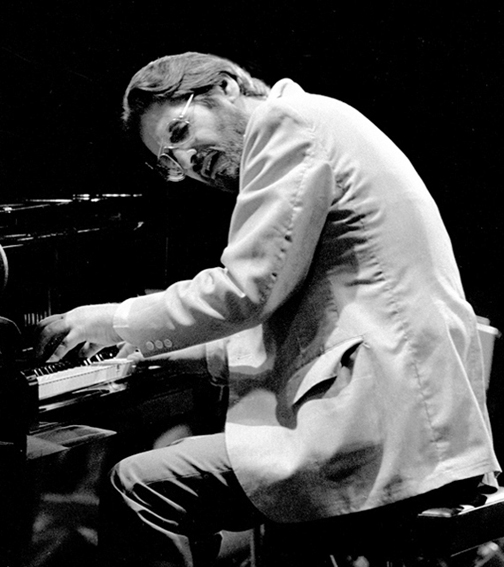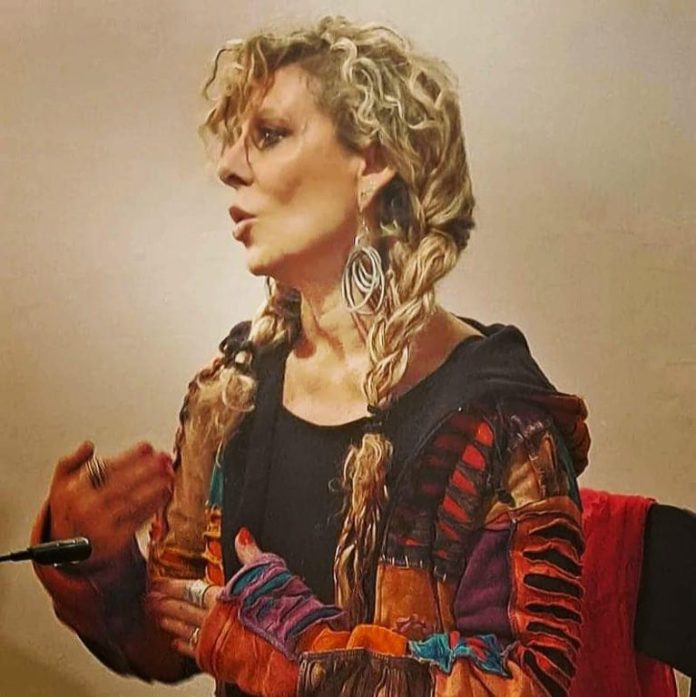Amore eterno… Eterno amore.” Uno spettacolo dedicato a Bill Evans, liberamente tratto dal libro “Il grande amore. Vita e morte con Bill Evans” di Laurie Verchomin. Lo ha portato in scena in scena l’associazione’ A Luna & ‘O Sole” nello spazio Casa del Mandolino in Piazzetta Museo Filangieri a Napoli.
Protagonista, la tragica, meravigliosa, difficile vita di Bill Evans. Una storia intensa, cruda, drammatica.
Evans è considerato uno dei maggiori esponenti di musica jazz, del secondo dopoguerra: pianista e compositore statunitense, nacque a Plainfield, in New Jersey il 16 di agosto 1929.
Fece parte del sestetto di Miles Davis con il quale nel 1959 registrò l’album Kind of blue. Molte delle sue composizioni, come Waltz for Debby, sono divenute degli standard e sono state registrate da molti altri artisti. Evans ricevette ben trentuno nomination ai Grammy Awards vincendone sette, e la sua popolarità lo portò a esser incluso nella Jazz Hall of Fame. Ebbe una infanzia difficile. A sette anni, il piccolo Bill iniziò a studiare il violino, ma anche il flauto e l’ottavino, successivamente li abbandonò, dedicandosi al pianoforte. Sicuramente lo studio di questi strumenti esercitarono una grande influenza sul suo stile musicale.
Tutto questo viene rappresentato magnificamente, con stile, con corde recitative profonde e un piglio di leggerezza grazie ad Anita Pavone che ne firma pure il testo e la regia.
Anita viene accompagnata nel suo percorso dalla bravissima musicista, pianista Mariella Pandolfi. Un magnifico viaggio artistico tra musica, videoproiezioni, teatro.
Ma Anita Pavone non è nuova a queste difficili messe in scena. Da ricordare un altro suo spettacolo dedicato alla scrittrice francese George Sand*.
Nella performance concentrata sul musicista, Anita si cala nei panni di Laurie, la giovane compagna di Bill Evans, che lo accompagnerà fino alla sua morte, standogli vicina in tutto il suo dolore. Lo fa recitando Laurie con passione e armonia.
Narra, così, la loro storia, racconta le loro vite tormentate esprimendo intensamente gli stati d’animo, dando colore e intensità alle battute da lei stessa scritte.
Anita riesce a catturare con bravura l’attenzione del folto pubblico, affascinandolo, mentre dà luce agli ultimi due anni di vita del genio del Jazz, musicista dall’anima sensibile, fragile, segnato da drammatiche vicissitudini familiari.
Erano gli anni 70/80 e New York era il cuore del jazz. Anni difficili dove il demonio della droga si insidia nel corpo nell’anima e nella mente del musicista e della giovane Laurie .
Ma chi è Laurie Verchomin? Una ragazza bella, con un corpo sodo da ballerina, probabilmente molto coraggiosa per i suoi 22 anni, forse semplicemente sprovveduta, sicuramente vulnerabile dinnanzi alla grandezza di quell’uomo, come Persefone, scende nel mondo di Ade per accompagnare il viaggio conclusivo del suo immenso amore fino alla fine.
Bill l’aveva scelta perché sapeva che Laurie l’avrebbe seguito per tutta la vita. Un atto di egoismo? Un folle amore? Sicuramente tutte e due le cose.
La concezione dello spettacolo con taglio filmico nasce dallo sdoppiamento stesso della splendida incarnazione della giovane donna che offre Anita e della musica di Mariella Pandolfi che fa da colonna sonora all’itinerario sentimentale con note sofisticate e avvolgenti. Affiancate da proiezioni delle immagini di Bill e Laurie e ancora di Bill nei suoi concerti in giro per il mondo.
L’ambientazione del palco ricorda i club degli anni ’90 con le luci basse, colorate, le bottiglie di whisky, l’ambiente intimo e accogliente. Dominano la passione travolgente, la musica, il sesso come sublimazione dell’appartenenza, la simbiosi che conducono Bill nel suo tragitto finale attraverso ciò che resta di un corpo martorizzato dalla tossicodipendenza.
Laurie è fresca di gioventù, inesperta, incapace di resistere al risucchio dell’amore (oltretutto trattasi di un uomo navigato, 30 anni più grande). Anita è Laurie su due fronti. Si presenta al pubblico introducendo la storia: «Era il 15 settembre del 1980 ed il corpo non mi fu mostrato. Per anni ho pensato che Bill non fosse morto veramente, ma che avesse architettato una sorta di fuga!».
Poi cambiando registro vocale, con voce più squillante e leggera, diventa la ragazza che continua il proprio percorso raccontando la coppia. Ecco che Laurie passa dalla ingenuità con cui, vedendolo per la prima volta, nel locale dove lei lavorava, in Canada, gli si avvicina solo perché si sente attratta all’accettare il primo invito di Bill a raggiungerlo a New York. Da allora è un susseguirsi di vicende che si rincorrono.
Lei va e viene dal Canada per raggiungerlo nei luoghi del tour di Bill. Da Francoforte a Chicago. Racconta, Anita, in un turbinio emotivo, regalando sfumature recitative, emozionando il pubblico. Facendolo entrare nel suo mondo come se assistessero a un film fatto di schizzi violenti, di passaggi repentini all’odio. Racconta, Anita, di fragilità, sofferenza , sublimazione di un amore che potrebbe sembrare malato
«Lui spesso si sedeva nudo al piano, ed io restavo ore ed ore a guardarlo stesa sul divano o per terra!».
Mariella Pandolfi con la sua musica intervalla le suggestioni emotive scandendo passaggi in cui la narrazione sviscera un momento di tormento, un momento di ritorno a casa di Laurie, un momento in cui emergono fatti violenti legati alla storia personale di Bill.
Toccante il finale, con una grande prova attoriale. Usando una voce matura, rotta dall’emozione, Laurie risponde alla telefonata di sua madre. «Mamma, no, mamma, sono felice, Bill è felice! Sono stata l’angelo di Bill, tu mi capisci, vero? L’ho consegnato alla morte ed ora non soffre più. E’ tutto a posto mamma. E’ tutto a posto!».
Lo spettacolo si snoda sulle dinamiche del teatro di narrazione, è essenziale, minimalista, diretto. L’amore, il sesso, la musica, le foto compongono un tragitto di empatia. A volte crudo, a volte romantico. Sempre dinamico, nella sua indagine interiore e viscerale.
Una testimonianza che lascia completo spazio alle composizioni complesse e malinconiche del genio del jazz e alla narrazione sincera della sua intimità. Dobbiamo riconoscere che vedere spettatori di Jazz con contaminazioni teatrali è davvero difficile. La nostra curiosità ci spinge ad ascoltare le loro opinioni.
Ci avviciniamo a una signora, le chiediamo cosa ne pensa, lei gentile risponde. Coraggiosa Anita Pavone che propone uno spettacolo cosi difficile e complicato. Sicuramente per amanti del jazz ma anche del teatro. Eccellente attrice è riuscita a farci rivivere l’ amore per il grande artista Bill Evans con geniale maestria, accompagnata, dalla eccellente e brava musicista Mariella Pandolfi.
Ancora un altro parere del pubblico, questa volta maschile. Ho sentito l’ingenuità e la purezza di una ragazza smarrita che non conosceva l’amore. Anita ci ha trasmesso l’emozione di un amore eterno attraverso parole e note musicali.
Il consenso dalla platea arriva con le parole di un altro signore: La bravissima Anita Pavone, seduta di fronte al pubblico su uno sgabello, accompagnata dalle magiche note della musica di Bill Evans magistralmente eseguita dalla pianista Mariella Pandolfi, mentre Anita con la sua straordinaria interpretazione ci ha fatto percepire forti emozioni nel dolore e l’estasi di un amore intenso e disperato, incondizionato facendoci rivivere gli ultimi anni della vita di Bill, trascinandoci nelle forti e senza limiti segnato dal dramma della droga.
Altrettanto entusiasta, un nuovo commento femminile: La magia della narrazione faceva scorrere, come in un film, le immagini della vita di due persone incatenate da un amore infinito, indissolubile; dall’intrigante momento del primo incontro fino alla fine, trasferendoci tutta la gioia, l’esaltazione, la dedizione, il sacrificio.
A volte il pubblico è sicuramente più preparato di alcuni critici, capace di sottolineare le forti emozioni trasmesse dalle nostre brave artiste che hanno dato tutto la loro anima in uno spettacolo struggente, magico nel suo genere. Da non perdere. E ci sarà occasione per vederlo perché sarà replicato a Napoli ma anche a Roma, in date ancora da definire.
NOTE
*George Sand, scrittrice francese. Il suo vero nome è Amantine Aurore Lucile Dupin, nasce il 1° luglio del 1804 a Parigi Dopo avere completato i “Contes d’une grand-mère” (“Novelle di una nonna”), George Sand muore l’8 giugno del 1876.

In copertina, Anita Pavone, interprete e regista dello spettacolo
Bill Evans/ Anita Pavone brings to the stage the American musician’s troubled love story with young Laurie Verchomin. A tale of passion and fragility in the sound of jazz
“Eternal love… Love for ever”. A performance dedicated to Bill Evans, loosely based on the book “Great Love. Life and death with Bill Evans” by Laurie Verchomin. It was staged by the association “A Luna & ‘O Sole” at the Casa del Mandolino in Piazzetta Museo Filangieri in Naples.
The protagonist, the tragic, wonderful, difficult life of Bill Evans. An intense, raw, dramatic story.
Evans is considered one of the greatest exponents of jazz music, after the Second World War: an American pianist and composer, he was born in Plainfield, New Jersey, on August 16, 1929.
He was a member of Miles Davis’s sextet, with whom he recorded the album Kind of Blue in 1959. Many of his compositions, such as Waltz for Debby, became standards and have been recorded by many other artists. Evans received no less than thirty-one Grammy Award nominations, winning seven, and his popularity led to his induction into the Jazz Hall of Fame. He had a difficult childhood. At the age of seven, little Bill began to study the violin, flute and piccolo, later abandoning them to concentrate on the piano. Certainly the study of these instruments had a great influence on his musical style.
All this is beautifully portrayed, with style, deep acting chords and a light-hearted flair thanks to Anita Pavone, who also signed the lyrics and direction.
Anita is accompanied in her journey by the very talented musician, pianist Mariella Pandolfi. A magnificent artistic journey between music, video projections and theater.
But Anita Pavone is not new to such difficult productions. Another of her performances, dedicated to the French writer George Sand*, is worth mentioning.
In this performance focused on the composer, Anita takes on the role of Laurie, the young companion of Bill Evans who accompanied him until his death and stood by him in all his grief. She does this by playing Laurie with passion and harmony.
She tells her story, recounts her troubled life, intensely expresses her moods, and gives color and intensity to the lines she wrote.
Anita skillfully captures the attention of the large audience, captivating them as she sheds light on the last two years of the life of the jazz genius, a musician with a sensitive, fragile soul, marked by dramatic family vicissitudes.
It was the 1970s and New York was the heart of jazz. Difficult years in which the demon of drugs lurked in the body, in the soul and in the mind of the musician and the young Laurie.
But who is Laurie Verchomin? A beautiful girl with the firm body of a dancer, probably very brave for her 22 years, maybe simply unaware, certainly vulnerable before the greatness of the man, like Persephone, she descends into the world of Hades to accompany the last journey of her immense love until the end.
Bill chose her because he knew that Laurie would follow him for the rest of his life. An act of selfishness? A mad love? Definitely both.
The cinematic conception of the play is based on the duality of the splendid embodiment of the young woman offered by Anita and Mariella Pandolfi’s music, which soundtracks the sentimental journey with refined and enveloping notes. Flanked by projections of images of Bill and Laurie and more of Bill in his concerts around the world.
The stage setting is reminiscent of the clubs of the 1990s with its low, colored lights, whiskey bottles and cozy, intimate ambience. Overwhelming passion, music, sex as a sublimation of belonging and symbiosis dominate, leading Bill on his final journey through what remains of a body ravaged by drug addiction.
Laurie is fresh from youth, inexperienced, unable to resist the pull of love (and this is a seasoned man, 30 years older). Anita is Laurie on two fronts. She introduces herself to the audience by telling the story: “It was September 15, 1980, and the body was not shown to me. For years I thought that Bill had not really died, but that he had engineered some kind of escape!”
Then she changes vocal register, in a squeakier, lighter voice, to become the girl who continues her own journey by telling the couple’s story. Here, Laurie goes from the naivete with which she first saw him in the club where she worked in Canada, approaching him only because she felt attracted to him, to accepting Bill’s first invitation to join him in New York. From then on, it is a series of events that chase each other.
She comes and goes from Canada to join him at Bill’s tour stops. From Frankfurt to Chicago. She narrates, Anita, in an emotional whirlwind, giving nuance to her acting, captivating the audience. She draws them into her world as if they were witnessing a movie of violent splashes, of sudden transitions to hate. She tells, Anita, of the fragility, the suffering, the sublimation of a love that may seem sick.
“He would often sit naked at the piano and I would stay for hours watching him lying on the couch or on the floor!”
Mariella Pandolfi with her music intersperses the emotional suggestions by punctuating passages in which the narrative unravels a moment of torment, a moment of Laurie’s return home, a moment in which violent facts related to Bill’s personal history emerge.
Touching is the finale, with a great acting performance. Using a mature voice, broken by emotion, Laurie responds to her mother’s phone call. “Mom, no, Mom, I’m happy, Bill is happy! I’ve been Bill’s angel, you understand me, don’t you? I delivered him to death, and now he’s not suffering anymore. It’s all right, Mom. It’s all right!”
The play unfolds on the dynamics of narrative theater; it is essential, minimalist, direct. Love, sex, music, photos compose a journey of empathy. Sometimes raw, sometimes romantic. Always dynamic in its inner, visceral investigation.
A testimony that leaves complete space for the jazz genius’ complex and melancholy compositions and sincere narrative of his intimacy. We must recognize that seeing viewers of Jazz with theatrical contaminations is indeed difficult. Our curiosity drives us to listen to their opinions.
We approach a lady, ask her what she thinks, she kindly replies. Brave Anita Pavone proposing such a difficult and complicated show. Definitely for jazz lovers but also for theater lovers. Excellent actress managed to make us relive the ‘love for the great artist Bill Evans with genius mastery, accompanied, by the excellent and talented musician Mariella Pandolfi.
Yet another opinion from the audience, this time a masculine one. I felt the naivete and purity of a lost girl who did not know love. Anita conveyed to us the emotion of an eternal love through words and musical notes.
The consensus from the audience comes with the words of another gentleman:The very talented Anita Pavone, seated in front of the audience on a stool, accompanied by the magical notes of Bill Evans’ music masterfully performed by pianist Mariella Pandolfi, while Anita with her extraordinary interpretation made us feel strong emotions in the pain and ecstasy of an intense and desperate, unconditional love making us experience the last years of Bill’s life, dragging us into the strong and limitless marked by the drama of drugs.
Sometimes the audience is definitely more prepared than some critics, able to emphasize the strong emotions transmitted by our talented artists who gave their all in a poignant, magical performance of this kind. Not to be missed. And there will be occasion to see it because it will be replicated in Naples but also in Rome, on dates yet to be defined.
In the foto, Bill Evans performing at the Montreux Jazz Festival (Switzerland) with his trio consisting of Marc Johnson, bass & Philly Joe Jones, drums, July 13, 1978. Photo: Brian McMillen / brianmcmillen@hotmail.comBill evans This file is licensed under the Creative Commons Attribution-Share Alike 3.0 Unported license.










